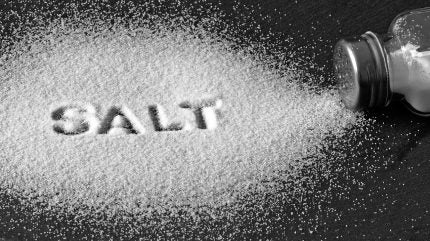

The US Food and Drug Administration (FDA) is taking the next step to encourage food manufacturers to reduce salt levels in their products.
Ultimately, the FDA wants consumers to eat less salt, or sodium as Americans tend to call the ingredient, in an effort to cut the rate of premature deaths from illnesses such as high blood pressure, one cause of heart disease and stroke.
The government-related body has today (15 August) launched “phase II” of its voluntary guidelines, with a target to reduce people’s daily intake of salt to about 2,750 milligrams per day over the next two and a half years.
If reached, that would be 20% below the levels of consumption in 2021, when the first phase was rolled out. However, 2,750 mg/day would still be above the 2,300 mg/day recommended by the Dietary Guidelines for Americans organisation for people 14 years and older.
Based on data from 2010, the FDA set out in October 2021 to cut sodium consumption from 3,400 mg/day to 3,000 mg/day under a rolling 2.5-year timeframe that expired in April this year.
“The initial set of targets [phase I] encouraged the food industry to reduce sodium levels in a wide variety of processed, packaged, and prepared foods,” the FDA said.
Access the most comprehensive Company Profiles
on the market, powered by GlobalData. Save hours of research. Gain competitive edge.

Company Profile – free
sample
Your download email will arrive shortly
We are confident about the
unique
quality of our Company Profiles. However, we want you to make the most
beneficial
decision for your business, so we offer a free sample that you can download by
submitting the below form
By GlobalData
“The phase II targets will continue to focus on commercially processed, packaged, and prepared foods in the marketplace. This guidance is particularly relevant as more than 70% of sodium intake in the US population comes from sodium added during food manufacturing and commercial food preparation.”
Nevertheless, despite the introduction of phase II, the FDA suggested there is more progress yet to me made on phase I, albeit the data cited is two years old.
“Preliminary data from 2022, show about 40% of the initial Phase I targets are very close to, or have already been reached, indicating early success of this effort,” the FDA said.
Jim Jones, the deputy commissioner for human foods at the FDA, said: “Reducing sodium in the food supply has the potential to be one of the most important public health initiatives in a generation.
“The early successes we’re seeing with sodium level reduction in certain foods is encouraging and indicative of the impact we believe our overall nutrition approach can have on the wellbeing of society.”
Jones said the body is also working on finalising an update on rules governing the definition of ‘healthy’ for food products and the parameters around front-of-pack labelling. It is also “exploring ways to reduce added sugars consumption”.
He added: “The FDA’s sodium reduction and other nutrition initiatives are central to a broader, whole-of-government approach to help reduce the burden of diet-related chronic diseases and advance health equity.”
The FDA’s sodium reduction efforts are part of the government’s National Strategy on Hunger, Nutrition and Health, which aims to cut diseases linked to diet by 2030.

